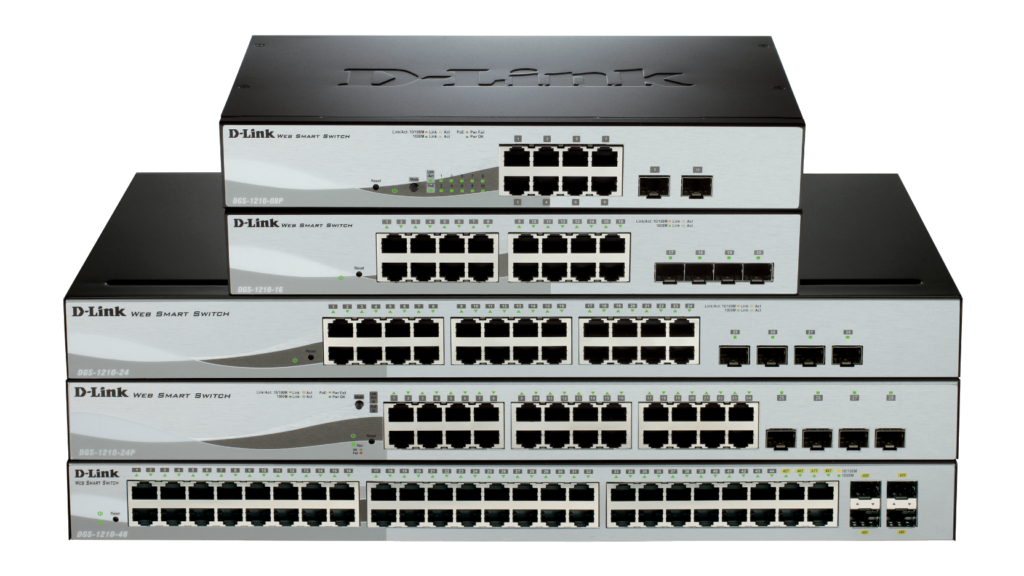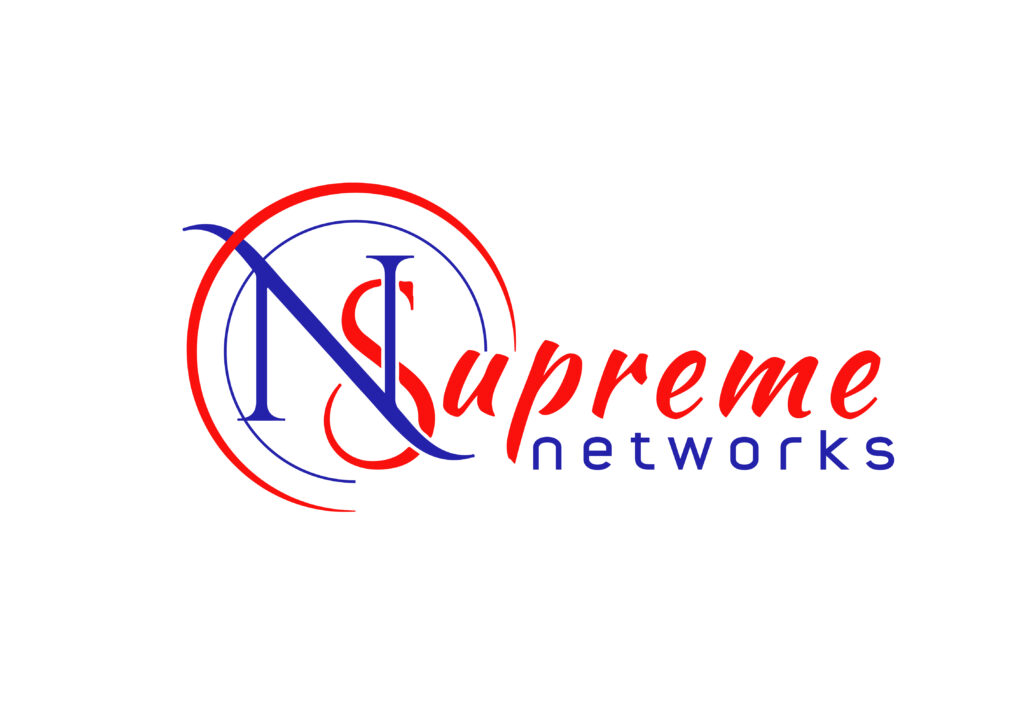D LINK NETWORK SWITCHES

D-Link produces a wide range of switches designed to meet the needs of different types of networks, including home networks, small to medium-sized business networks, and large enterprise networks. Some of the popular D-Link switches are:
- Unmanaged switches: D-Link’s unmanaged switches are plug-and-play devices that require no configuration and are ideal for small home or office networks.
- Smart switches: D-Link’s smart switches provide basic management features, such as VLAN and QoS, and are suitable for small to medium-sized business networks.
- Managed switches: D-Link’s managed switches provide advanced management features, such as SNMP and CLI, and are ideal for large enterprise networks.
- PoE switches: D-Link’s PoE switches provide power over Ethernet to devices such as wireless access points, IP cameras, and VoIP phones, eliminating the need for separate power supplies.
- Industrial switches: D-Link’s industrial switches are designed to withstand harsh environments and provide reliable connectivity for industrial networks.
D LINK NETWORKS SWITCHES SIZES
D-Link offers a wide range of switches with varying sizes, depending on the number of ports and features required. Here are some of the common sizes of D-Link switches:
- Desktop switches: These are small switches designed for use on a desk or in a small office/home office (SOHO) environment. They typically have between 5 and 8 ports and are unmanaged switches. This means they do not have advanced features like VLANs or Quality of Service (QoS). Desktop switches are ideal for connecting a small number of devices like desktop computers, printers, and routers.
- Rackmount switches: These switches are designed to be mounted in a standard 19-inch rack. They are commonly used in data centers, server rooms, and large enterprise networks. Rackmount switches come in various sizes ranging from 8 to 48 ports or more and can be managed or unmanaged, depending on the model. They offer advanced features like VLANs, QoS, and SNMP management. Hence making them ideal for large networks with many devices and users.
- Modular switches: These switches are designed to be customizable, with interchangeable modules that allow you to add or remove ports and features as needed. Modular switches are typically found in large enterprise networks where flexibility and scalability are important. They can have a wide range of port densities, from 4 to 48 ports per module, and can be managed or unmanaged.
- PoE switches: These switches are designed to provide power to PoE-enabled devices like IP cameras, wireless access points, and VoIP phones. PoE switches come in various sizes, ranging from 5 to 48 ports or more. They can be managed or unmanaged, depending on the model. They offer advanced features like VLANs, QoS, and SNMP management. This makes them ideal for networks with many PoE-enabled devices.
D LINK POE GIGABIT SWITCHES
D-Link’s Power over Ethernet (PoE) Gigabit switches provide both high-speed network connectivity and power to PoE-enabled devices, such as IP cameras, wireless access points, and VoIP phones. Some of the features of D-Link’s PoE Gigabit switches include:
- Gigabit Ethernet: D-Link’s PoE Gigabit switches provide high-speed Gigabit Ethernet connectivity. Enables fast data transfer rates and low latency.
- PoE support: D-Link’s PoE Gigabit switches support both the IEEE 802.3af and 802.3at PoE standards. This provide up to 30 watts of power per port, depending on the device.
- PoE budget: PoE switches come with a PoE budget, which determines the amount of power that can be supplied to PoE-enabled devices. D-Link’s PoE Gigabit switches come with different PoE budgets, ranging from 64 watts to 370 watts, depending on the number of PoE-enabled ports.
- VLAN support: Enables the segmentation of network traffic and providing better network performance, security, and management.
- QoS support: They support Quality of Service (QoS), which enables the prioritization of certain types of network traffic. Hence ensuring that critical applications, such as voice and video, receive priority over other types of traffic.
- Management features: D-Link’s PoE Gigabit switches come with management features, such as web-based management and SNMP. These features enables network administrators to manage and monitor network performance and status.
- Energy efficiency: They come with energy-saving features, such as Energy-Efficient Ethernet (EEE), which reduce power consumption and help to lower operating costs.
MANAGED D LINK SWITCHES
D-Link’s managed switches come with a variety of features that provide advanced management and configuration capabilities, such as:
- VLAN support: Virtual Local Area Networks (VLANs) enable the segmentation of a network into separate virtual networks. This provides better network performance, security, and management.
- Quality of Service (QoS): QoS enables the prioritization of certain types of network traffic. This ensures that critical applications, such as voice and video, receive priority over other types of traffic.
- Port mirroring: Port mirroring enables the monitoring of network traffic by copying packets from one port to another. They also allow network administrators to troubleshoot network issues and analyze network traffic.
- Link aggregation: Link aggregation enables the combination of multiple physical links into a single logical link. This provides better network performance and redundancy.
- Access Control Lists (ACLs): ACLs enable network administrators to define rules that restrict access to certain types of network traffic or network resources, providing better network security.
- Simple Network Management Protocol (SNMP): SNMP enables the monitoring and management of network devices, such as switches, routers, and servers. They also provide network administrators with real-time information about network performance and status.
- CLI and Web-based Management: Managed switches come with both Command Line Interface (CLI) and web-based management interfaces. This provides network administrators with a choice of management options.
APPLICATION D LINK MANAGED SWITCHES
D-Link’s managed switches are designed for applications that require advanced management and configuration capabilities, such as:
- Enterprise networks: Managed switches are ideal for large enterprise networks that require advanced management and security features, such as VLAN, QoS, and SNMP.
- Data centers: Managed switches are used in data centers to connect servers and storage devices. They also provide advanced features, such as link aggregation and redundancy.
- VoIP networks: Managed switches are used in VoIP networks to provide Quality of Service (QoS) features. These features ensure that voice traffic is prioritized over other types of traffic to prevent delay and jitter.
- Video surveillance networks: They are commonly used in video surveillance networks to provide Power over Ethernet (PoE) to IP cameras. They also ensure that video traffic is prioritized over other types of traffic.
- Educational institutions: Managed switches are used in educational institutions. They provide advanced security features (such as Access Control Lists (ACLs) and Port Security) to protect against unauthorized access and network attacks.
POE NON GIGABIT D LINK SWITCHES
D-Link’s Power over Ethernet (PoE) non-Gigabit switches provide both network connectivity and power to PoE-enabled devices, such as IP cameras, wireless access points, and VoIP phones. These switches are designed for small to medium-sized businesses that do not require Gigabit Ethernet speeds. Some of the features of D-Link’s PoE non-Gigabit switches include:
- Fast Ethernet: D-Link’s PoE non-Gigabit switches provide Fast Ethernet connectivity, which supports data transfer rates of up to 100 Mbps.
- PoE support: D-Link’s PoE non-Gigabit switches support both the IEEE 802.3af and 802.3at PoE standards. This provide up to 30 watts of power per port, depending on the device.
- PoE budget: PoE switches come with a PoE budget, which determines the amount of power that can be supplied to PoE-enabled devices. D-Link’s PoE non-Gigabit switches come with different PoE budgets, ranging from 24 watts to 64 watts, depending on the number of PoE-enabled ports.
- VLAN support: D-Link’s PoE non-Gigabit switches support VLANs. This enabling the segmentation of network traffic and providing better network performance, security, and management.
- QoS support: The switch supports Quality of Service (QoS), which enables the prioritization of certain types of network traffic. This ensures that critical applications, such as voice and video, receive priority over other types of traffic.
- Management features: They come with management features, such as web-based management and SNMP. This enables network administrators to manage and monitor network performance and status.
- Energy efficiency: They come with energy-saving features, such as Energy-Efficient Ethernet (EEE). This reduces power consumption and help to lower operating costs.
D LINK UNMANAGED SWITCHES
D-Link’s unmanaged switches are designed for plug-and-play connectivity, and typically come with basic features that provide reliable network connectivity. These features include:
- Auto-MDI/MDIX: Auto-MDI/MDIX automatically adjusts the crossover function of the Ethernet ports. Hence eliminating the need for crossover cables, and making it easy to connect devices to the network.
- Auto-negotiation: Auto-negotiation enables the switch to automatically detect the speed and duplex mode of the connected devices. This ensures that devices can communicate with each other at the highest possible speed.
- Plug-and-play: Unmanaged switches are designed for plug-and-play connectivity. This means that they require no configuration and can be installed quickly and easily.
- Energy efficiency: Unmanaged switches typically come with energy-saving features, such as Energy-Efficient Ethernet (EEE), which reduce power consumption and help to lower operating costs.
- Compact design: They are typically small and compact, making them ideal for use in tight spaces or where space is limited.
APPLICATIONS OF D LINK UNMANAGED SWITCHES
D-Link’s unmanaged switches are ideal for applications where basic network connectivity is required, but no advanced management or configuration is necessary. Some of the common applications of unmanaged switches are:
- Home networks: They are suitable for home networks where a few devices need to be connected to the internet, such as computers, game consoles, and smart TVs.
- Small offices: Unmanaged switches can be used in small offices to connect a few computers and printers to the network.
- Retail stores: Unmanaged switches can be used in retail stores to connect point-of-sale terminals, cash registers, and other devices to the network.
- Guest networks: They can be used in guest networks, such as in hotels, to provide basic connectivity to guests.
- Kiosks: Unmanaged switches can be used in kiosks to provide network connectivity to the kiosk and any devices connected to it, such as touchscreens and sensors.
D LINK NETWORKS SWITCHES OVERALL
D-Link offers a wide range of switches that are designed to meet the needs of small to large businesses, as well as home users. Whether you require unmanaged switches for simple connectivity, or managed switches for advanced features like VLANs and QoS, D-Link has a switch that can meet your needs.
In addition, D-Link offers PoE switches for powering PoE-enabled devices, and modular switches for customizable and scalable solutions. D-Link switches also offer energy-saving features, such as Energy-Efficient Ethernet (EEE). EEE helps to reduce power consumption and lower operating costs.
They are easy to install and configure, and they offer a range of management options, including web-based management, SNMP, and command-line interface (CLI) for advanced users. D-Link switches are also designed for reliability and durability, with features like port mirroring, Link Aggregation Control Protocol (LACP). Loopback Detection which help to prevent network downtime and ensure maximum uptime.
Overall, D-Link switches are a reliable and cost-effective solution for networking needs, with a wide range of features, sizes, and management options to meet the needs of businesses and home users alike
QUICK LINKS
D-Link DES-F1016P-E/B 16-port Fast Ethernet Unmanaged PoE+ Surveillance Switch
BOSCH GBH 5-40 D PROFESSIONAL ROTARY HAMMER WITH SDS MAX 1100W
